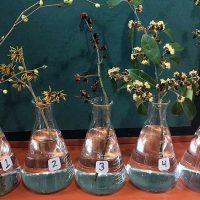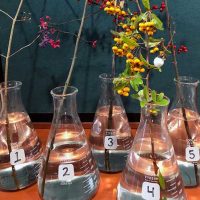Our 2020 Northwest Flower and Garden Festival Display: “Gateway to a Greener Earth”

The following ex-situ conservation plants are all listed as endangered in their region of origin due to habitat loss and climate change:
1) Araucaria araucana Monkey Puzzle
This unique looking conifer is native to the Chilean Andes and considered a living fossil dating back over 60 million years.
The Mapuche Pehuenche people of the Andes value these trees for their edible seeds and spiritual significance.
All About Hamamelidaceae: The Witch Hazel Family

1) Corylopsis glabrescens Fragrant Winter Hazel
Corylopsis are Asian natives which bloom in late winter or early spring with profusions of sunny yellow flowers dangling from bare branches.
Corylopsis glabrescens is the hardiest of the genus and can grow up to 15 feet high and wide.
Flower buds are about to burst open on this shrub in the Witt Winter Garden.
Selected Cuttings from the Washington Park Arboretum

1) Abies pinsapo var. marocana
This fir is native to Morocco, where it occupies a small area in the mountains south of Tetuan.
Not as tall as the type, this variety has needles similar to A. pinsapo but are wider and longer.
Located along the Arboretum Loop Trail, just south of parking lot #19.
2) Cunninghamia konishii
Cunninghamia is a genus of just three species native to northeastern Asia.
Read moreAmeriCorps Environmental Programs Steward – Chloe’s Story of Service

My name is Chloe, and I am serving at the University of Washington Botanic Gardens through AmeriCorps and Washington Service Corps. Before I go into the duties of my specific position, I’d like to give a brief explanation of what it means to serve as an AmeriCorps member. AmeriCorps members often find themselves recruiting volunteers and promoting active community engagement to better serve their local neighborhood.
Read moreNew Selected Cuttings Welcome the New Year to the Washington Park Arboretum

1) Illicium henryi Henry’s Star Anise
Native to China, this pungent plant is related to culinary star anise (Illicium verum). Specimens can be found on the Sino-Himalayan hillside and along the western edge of the Magnolia Collection.
The genus name Illicium comes from the Latin for “allurement” or “inducement from an enticing scent”. This refers to the aromatic scent released by bruised or crushed leaves.
Winter Interest at the Washington Park Arboretum

1) Edgeworthia chrysantha Paperbush
Native to China, the inner bark of this plant may be used to make quality paper.
The silvery flower buds will open in mid-winter to very fragrant, creamy-yellowish flowers.
Edgeworthia can be found on the west side of the Graham Visitors Center in the Pacific Connections China Garden and the Witt Winter Garden.
2) Hamamelis vernalis ‘Christmas Cheer’ Witch Hazel
This witch hazel is native to the Ozark Plateau.
Read moreFall Fruits at the Washington Park Arboretum

1) Callicarpa sp. Beautyberry
The small, attractive metallic and purple berries give this ornamental shrub its common name.
The berries stay on the plant late into winter and are an important food source for wildlife.
This popular landscape plant provides a splash of color as fall sets in.
This and other Callicarpa can be seen from Arboretum Drive in our nursery.
Late Fall Interest in the Pacific Connections Garden

1) Cardiocrinum giganteum Giant Himalayan Lily
As its name suggests, this is a large lily that grows to be 8 to 10 feet tall with huge fragrant white flowers followed by attractive seed pods that progress from green to brown and contain hundreds of thin-layered seeds.
The remaining stalks with seed pods can be found in the Pacific Connections China Garden.
All About the Genus Picea

1) Picea orientalis Oriental Spruce
This popular ornamental spruce can grow up to 150 feet and is native to the Caucasus Mountains and northern Asia Minor.
This species is prized for its gracefully pendulous foliage and for the young cones which are deep purple.
A grove of these trees can be found on the northeast side of the Pinetum.
2) Picea morrisonicola Taiwan Spruce
Endemic to the mountains of Taiwan, this spruce has slender, delicate shoots.
Read moreA Spotlight on Memorials at the Washington Park Arboretum

Over the years, numerous memorials have been developed in the Arboretum, and several plant collections memorialize individuals. The following are some memorials, and a nearby plant.
1) Camellia japonica ‘Oridono-nishiki’ Foxworthy Benches
This memorial, composed of three benches in memory of Mary Hughes Foxworthy, was installed in 1961 along the trail traversing Rhododendron Glen above the Lookout Gazebo.
There are thousands of cultivars of Camellia japonica in cultivation, with many different colors and forms of flowers.